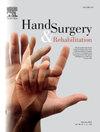QuickDASH: Reliability in the assessment of carpal tunnel syndrome
IF 1
4区 医学
Q4 ORTHOPEDICS
引用次数: 0
Abstract
Objective
The Disabilities of the Arm, Shoulder, and Hand (DASH) questionnaire, along with its shortened version QuickDASH, are widely used self-assessment tools for evaluating upper limb function across various acute and chronic conditions. These tools aim to standardise outcome measures globally, contingent upon certified versions and adherence to calculation guidelines. While overall reliability of the QuickDASH is established, question-by-question reproducibility and methodology have not been rigorously assessed. Carpal tunnel syndrome was chosen for testing the reliability of the QuickDASH.
This study aimed to evaluate the question-by-question reliability of the QuickDASH in carpal tunnel syndrome patients. Additionally, we surveyed members of the French Society of Hand Surgery regarding their QuickDASH usage practices and examined patients' functional expectations to correlate them with the questionnaire items. Our hypothesis suggested that response reliability might be affected by patient and practitioner factors or data collection methods.
Materials and methods
A non-interventional, single-center study was conducted from July 2023 to June 2024, including patients whose carpal tunnel syndrome was confirmed by clinical and electrophysiological tests. Patients completed the QuickDASH three times on consecutive days. Demographic, clinical, and paraclinical data were collected, including pain medication, ease of completion, age, sex, body mass index, profession, occupational health status, smoking, diabetes, thoracic outlet syndrome, and electroneuromyogram data. In October 2023, an online survey queried SFCM members on their QuickDASH application methods, response management, and knowledge of guidelines. Finally, A separate group of patients was interviewed preoperatively to describe their symptoms openly and symptoms were then compiled for analysis.
Results
The QuickDASH was found easy to complete by 93.3% of patients. The intraclass correlation scores indicated strong reliability for the overall QuickDASH, with 93% pre-operatively, 87% post-operatively and 92% in the overall population. However, question-specific intra-class correlations revealed less consistency, particularly for certain items post-operatively. Among surveyed practitioners, 65.5% reported that patients completed the QuickDASH autonomously, and 63.2% provided direct clarification when needed. While 58.1% of practitioners indicated the QuickDASH did not affect therapeutic decisions, 41.9% acknowledged its potential impact. Word clouds created from open-ended patient responses highlighted pain, tingling, and nocturnal symptoms as primary concerns pre-operatively.
Conclusion
The QuickDASH questionnaire demonstrated high reliability for measuring upper limb function in carpal tunnel syndrome patients, though some questions showed variability in their responses. Despite its widespread use, the implementation of the QuickDASH in clinical practice shows room for improvement, particularly regarding practitioner understanding and handling of missing data. The increased use of Patient-Reported Outcomes Measures should encourage us to develop more specific tools that are closer to patients' symptoms and functional requirements.
QuickDASH:评估腕管综合征的可靠性。
目的:臂肩手功能障碍问卷(DASH)及其缩略版QuickDASH是广泛应用于各种急慢性疾病上肢功能评估的自我评估工具。这些工具的目的是在全球范围内标准化结果测量,取决于认证版本和对计算指南的遵守。虽然QuickDASH的整体可靠性已经建立,但逐个问题的可重复性和方法尚未得到严格评估。选择腕管综合征作为测试QuickDASH可靠性的对象。本研究旨在评估QuickDASH在腕管综合征患者中的逐题可靠性。此外,我们调查了法国手外科学会的成员,了解他们的QuickDASH使用情况,并检查了患者的功能期望,以将其与问卷项目联系起来。我们的假设表明,反应可靠性可能受到患者和医生因素或数据收集方法的影响。材料与方法:于2023年7月至2024年6月进行非介入性、单中心研究,纳入经临床及电生理检查证实的腕管综合征患者。患者连续3天完成QuickDASH测试。收集人口统计学、临床和临床旁数据,包括止痛药、完成度、年龄、性别、体重指数、职业、职业健康状况、吸烟、糖尿病、胸廓出口综合征和神经肌电图数据。2023年10月,SFCM成员进行了一项在线调查,询问他们的QuickDASH应用方法、响应管理和指南知识。最后,术前对另一组患者进行访谈,公开描述其症状,然后对症状进行汇总分析。结果:93.3%的患者认为QuickDASH易于完成。类内相关评分显示整体QuickDASH具有很强的可靠性,术前为93%,术后为87%,总体人群为92%。然而,特定问题的类内相关性显示出较少的一致性,特别是对于某些项目术后。在接受调查的从业者中,65.5%的人报告患者自主完成QuickDASH, 63.2%的人在需要时提供直接的说明。虽然58.1%的从业者表示QuickDASH不影响治疗决策,但41.9%的从业者承认其潜在影响。从开放式患者反应中产生的词云强调了术前主要关注的疼痛、刺痛和夜间症状。结论:QuickDASH问卷在测量腕管综合征患者上肢功能方面具有较高的可靠性,但部分问题的回答存在差异。尽管QuickDASH被广泛使用,但它在临床实践中的实施显示出改进的空间,特别是在医生对缺失数据的理解和处理方面。越来越多地使用患者报告的结果测量方法,应该鼓励我们开发更具体的工具,更接近患者的症状和功能需求。
本文章由计算机程序翻译,如有差异,请以英文原文为准。
求助全文
约1分钟内获得全文
求助全文
来源期刊

Hand Surgery & Rehabilitation
Medicine-Surgery
CiteScore
1.70
自引率
27.30%
发文量
0
审稿时长
49 days
期刊介绍:
As the official publication of the French, Belgian and Swiss Societies for Surgery of the Hand, as well as of the French Society of Rehabilitation of the Hand & Upper Limb, ''Hand Surgery and Rehabilitation'' - formerly named "Chirurgie de la Main" - publishes original articles, literature reviews, technical notes, and clinical cases. It is indexed in the main international databases (including Medline). Initially a platform for French-speaking hand surgeons, the journal will now publish its articles in English to disseminate its author''s scientific findings more widely. The journal also includes a biannual supplement in French, the monograph of the French Society for Surgery of the Hand, where comprehensive reviews in the fields of hand, peripheral nerve and upper limb surgery are presented.
Organe officiel de la Société française de chirurgie de la main, de la Société française de Rééducation de la main (SFRM-GEMMSOR), de la Société suisse de chirurgie de la main et du Belgian Hand Group, indexée dans les grandes bases de données internationales (Medline, Embase, Pascal, Scopus), Hand Surgery and Rehabilitation - anciennement titrée Chirurgie de la main - publie des articles originaux, des revues de la littérature, des notes techniques, des cas clinique. Initialement plateforme d''expression francophone de la spécialité, la revue s''oriente désormais vers l''anglais pour devenir une référence scientifique et de formation de la spécialité en France et en Europe. Avec 6 publications en anglais par an, la revue comprend également un supplément biannuel, la monographie du GEM, où sont présentées en français, des mises au point complètes dans les domaines de la chirurgie de la main, des nerfs périphériques et du membre supérieur.
 求助内容:
求助内容: 应助结果提醒方式:
应助结果提醒方式:


